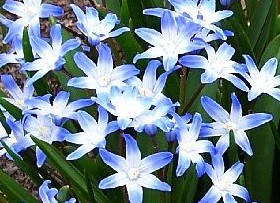Chionodoxa (ky on o DOX a )from the Greek chion meaning snow and doxa meaning glory
 The common name, glory of the snow, reflects the Greek meaning of the botanical name and the early blooming habit of the plant. These charming bulbs bloom in early spring sometimes when snow is still on the ground. They are members of the asparagus family, Asparagaceae, and in the same subfamily as hyacinths, grape hyacinths, scilla, and pineapple lilies. There are six members of the genus Chionodoxa and all prefer well drained soil and cool climates especially in summer. They need sun but do well planted under deciduous trees.C. luciliae is considered the best of the genus and is the one most commonly found in gardens. It has two linear leaves that arise in the spring and are followed by three to six intense blue flowers one inch wide and with a white center. The flowers will last three to four weeks if the weather is cool. Three varieties are available: var. alba with white flowers on six inch stems; var. rosea with pink flowers on eight inch stems; var, gigantean with blue flowers 2” across. Bulbs are best planted in masses of at least fifty and will spread if they like their site. Another good species of Chionodoxa is C. sardensis, with sky blue flowers without a white center; it blooms earlier than C. luciliae.
The common name, glory of the snow, reflects the Greek meaning of the botanical name and the early blooming habit of the plant. These charming bulbs bloom in early spring sometimes when snow is still on the ground. They are members of the asparagus family, Asparagaceae, and in the same subfamily as hyacinths, grape hyacinths, scilla, and pineapple lilies. There are six members of the genus Chionodoxa and all prefer well drained soil and cool climates especially in summer. They need sun but do well planted under deciduous trees.C. luciliae is considered the best of the genus and is the one most commonly found in gardens. It has two linear leaves that arise in the spring and are followed by three to six intense blue flowers one inch wide and with a white center. The flowers will last three to four weeks if the weather is cool. Three varieties are available: var. alba with white flowers on six inch stems; var. rosea with pink flowers on eight inch stems; var, gigantean with blue flowers 2” across. Bulbs are best planted in masses of at least fifty and will spread if they like their site. Another good species of Chionodoxa is C. sardensis, with sky blue flowers without a white center; it blooms earlier than C. luciliae.